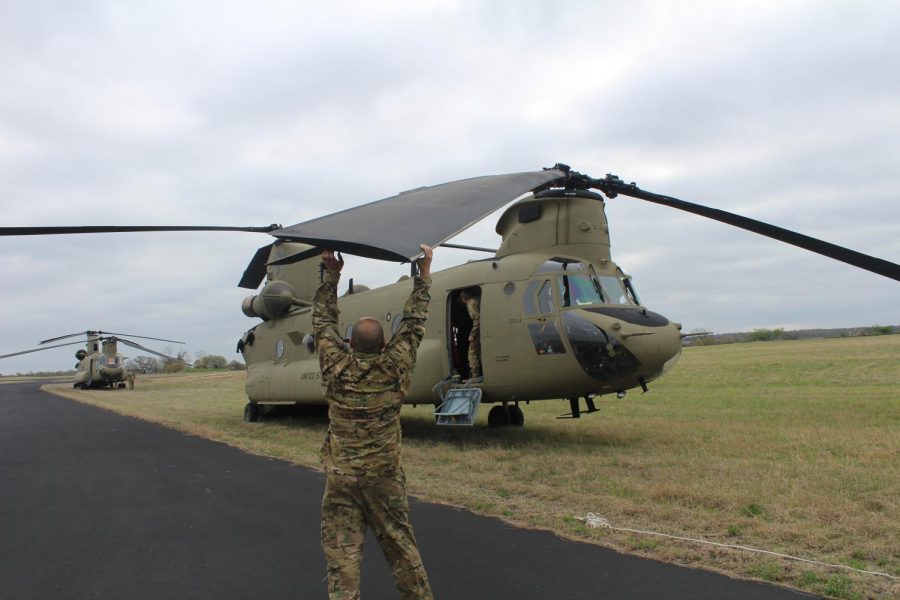Here’s what you need to know about National POW/MIA day
United States National Guard Airman ties down Chinook plane rotors to the ground due to high winds.
Sept. 18 is National Prisoner of War/Missing in Action (POW/MIA) is a day to honor prisoners of war and soldiers missing in action.
Every year there is a national ceremony held at the Pentagon featuring members from each branch of the military and other high ranking government officials. Other observances are held across the country on military bases, ships at sea, in state capitols, and in schools and veterans’ facilities.
No matter where they are held, National POW/MIA Recognition Day ceremonies and observances share the commonality of honoring those who were held captive in war and have since been returned, and those who remain missing. “You Are Not Forgotten” is the main phrase that drives this day of recognition.
In this day of remembrance the Tarleton Corp of Cadets Commandant and Dean of Leadership and Military College, Colonel Kenny Weldon of the U.S. Air Force, spoke about the importance of this day to him personally.
“POW/MIA Recognition Day exists to ensure that Americans remember to stand behind those who serve and to make sure we do everything we can to account for those who have never returned,” said Weldon.
Many service members suffered as prisoners of war during decade’s worth of varying military conflicts, and while some of them were lucky and made it home, tens of thousands never did.
In order to understand and fully comprehend the importance of this day, all you need to do is consult the sheer statistics of American soldiers who have been listed as prisoners of war, or soldiers missing in action.
According to a Congressional Research Service report on prisoners of war:
- 130,201 World War II service members were imprisoned and 14,072 died during the war
- 7,140 Korean War service members were imprisoned and 2,701 died during the war
- 725 Vietnam War service members were imprisoned and 64 died during the war
- 37 service members have been imprisoned during conflicts since 1991, including both Gulf Wars
According to the Defense POW/MIA Accounting Agency 83,114 Americans who fought and served in these wars are still missing, including:
- 73,515 from World War II (approximated due to conflicting data)
- 7,841 from the Korean War
- 1,626 from the Vietnam War
- 126 from the Cold War
- 6 from conflicts since 1991
The Defense POW/MIA Accounting Agency also states that about 75% of the missing soldiers are presumed to be somewhere in the Asia-Pacific region and more than 41,000 soldiers have been presumed lost at sea.
If you’ve ever heard of prisoners of war and soldiers missing in action you’ve probably also seen the iconic black and white flag. The traditional POW/MIA flag was actually created many years before the recognition day became official.
In 1971, thanks to a woman named Mary Hoff, the first POW/MIA recognition flag was created. She was one of the many wives waiting to see if her husband, Navy Lieutenant Commander Michael Hoff, would ever return home after his plane had been shot down over Laos, North Korea. Hoff went to World War II pilot Newt Heisley to help designed the iconic flag. It was made in black and white to represent the sorrow, anxiety and hope symbolized by the image of the gaunt man featured on the flag.
On every POW/MIA Recognition day since 1982, the flag has flown directly below the stars and stripes at the White House, which is the only other flag to do so. The flag has also been ordered to be displayed on Armed Forces Day, Memorial Day, Flag Day, Independence Day, and Veterans Day.
Since 2018 the DPAA has conducted 65 recovery missions and 50 investigative missions in countries around the world to uncover military personnel lost during WWII, the Korean War, and the Vietnam War, as well as other various conflicts.
Weldon also quoted the U.S. Military Code of Conduct, which states, “the military plays an ever-increasing role in peacekeeping, humanitarian assistance and other operations other than war, thus leading service members to an increased risk of capture by hostile forces.”
National POW/MIA Recognition Day serves as a call to action, reminding the nation to rededicate our efforts for our service members. As a nation we are responsible for bringing our patriots home and for caring for our military families awaiting word of their loved ones. Today, show honor and your support to these veterans and their families.
Recognize the men and women who were prisoners of war and those who are still missing in action. Remember them and stand up for them to be brought home. Use #POWMIARecognitionDay to post on social media and show your solidarity with the movement.



